Diplomatic uniform
Diplomatic uniforms are ornate uniforms worn by diplomats—ambassadorial and consular officers—at public occasions. Introduced by European states around 1800 and patterned on court dress, they were abandoned by most countries in the twentieth century, but diplomats from some countries retain them for rare, formal occasions.
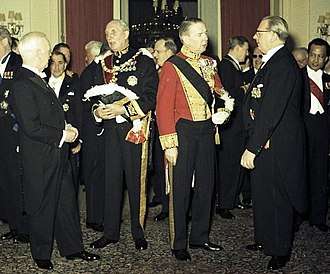
History
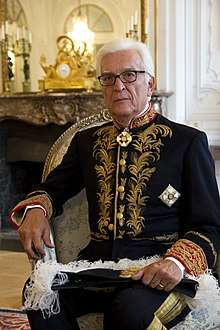
Up until the 18th century, diplomats (who usually belonged to the high nobility) wore their own court clothing to solemn occasions. Diplomatic uniforms were first introduced by France in 1781 and widely adopted by other European nations around 1800 in the course of administrative reforms undertaken as a response to the French Revolution and the Napoleonic Wars. In several countries, diplomatic uniforms were among the first civilian uniforms to be adopted. Apart from saving diplomats (who now increasingly were not independently wealthy) the expense of maintaining a full court wardrobe, diplomatic uniforms served to emphasize the importance of the office and to deemphasize the person of its holder.[1]
Several non-European courts adopted European-style diplomatic uniforms during the 19th century. Notably, Japan during the Meiji Revolution introduced European uniforms instead of traditional clothing for all officials in 1872.[1] The Ottoman court was another non-European court that adopted the uniforms, which were introduced during the Tanzimat period. The final period during which the majority of diplomatic services retained formal uniforms for the accredited members of their overseas missions was that prior to World War II. A detailed study of contemporary uniforms, both military and civil, published in 1929[2] gives descriptions of the diplomatic uniforms still being worn by representatives of the majority of states then in existence. These included most European nations and a number of Latin American and Asian countries. It is however noted that several states which had only been created following World War I, had not adopted diplomatic uniforms and that others had discarded them. The uniforms described are nearly all of the traditional style of bicorne hat and tailcoat with braiding according to grade, from third secretaries to ambassadors. Consular staff were less likely to have authorised uniforms than their diplomatic colleagues and where consular uniforms existed they were generally of simpler style. As an example, the British Consular Service had silver braiding rather than the gold of diplomats.
While most countries abandoned diplomatic uniforms at some time during the 20th century, several long-established foreign services have retained them for wear by senior staff on ceremonial occasions such as the formal presentation of credentials by ambassadors. A photo of the 2001 New Year's reception at the Vatican shows the ambassadors of Monaco, the Netherlands, Thailand, the United Kingdom, Spain, France, and Belgium all clad in diplomatic uniform.[1]
Design
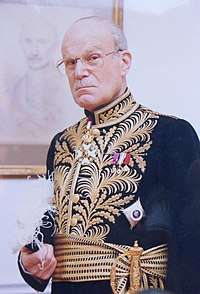
Diplomatic uniforms generally followed 19th century court fashion and usually included a tailcoat with standing collar, breeches or pantaloons, a sword and a two-cornered plumed hat ("bicorne"). There were normally at least two versions, a dress uniform for ceremonial events and a simpler version for less formal occasions which nevertheless required the use of uniform dress.[1] Unlike their military and naval counterparts, diplomats did not wear uniforms for everyday purposes but substituted the appropriate civilian clothing.
Diplomatic uniforms were usually richly embroidered with gold similar to the uniforms of high court officials. Diplomatic rank was distinguished by the amount and quality of the embroidery. In contrast to military uniforms, which underwent rapid changes throughout the 19th and early 20th century, the diplomatic uniforms tended to keep their traditional design.[1] While the uniforms of the different foreign services generally shared the common features noted above, there were considerable national differences, though often of minor detail.
Thus, as examples, French ambassadors were distinguished by pearl-handled court swords with gold and silk frogs (sword attachments), their Portuguese colleagues by oak leaves and acorns represented in gold embroidery on their dress coats, while Norwegian diplomats wore gold embroidery of pine cone design on their dark blue "swallow-tail" coats.[3] Belgian diplomats of all ranks had "royal blue" tail coats and retained the 18th century fashion of white breeches and stockings with low shoes.[4] Today, Belgian diplomats wear blue and gold waist sashes, Spanish diplomats red cuffs on their dark blue tail-coats,[5] and Danish diplomats distinctive red coats.[6]
Diplomatic uniforms by country
Germany
In 1817, Prussian diplomats received as uniforms dark blue tail coats with cuffs and a standing collar of black velvet, decorated with oak leaf scrolls embroidered in gold. In 1888, the German Empire introduced the Altbrandenburgischer Waffenrock, a long military-style coat, as the general state uniform for high-ranking officials.[1] Military uniform was worn instead of court uniform by military officers and by those political figures who were reserve officers, which included most diplomats: it was practically impossible under the Empire for one to be a civil servant or a state secretary of ministerial rank without also being a reserve officer.
Diplomatic uniforms were abandoned under the Weimar Republic, but the Nazi regime, which had a general fondness for uniforms, reintroduced them. The stage designer Benno von Arent designed the "startling" Nazi diplomatic uniform, consisting of a dark blue tailcoat whose modern lapels were embroidered with silver oak leaves, a silver sash, a silver aiguillette and a small dagger.[1]
Japan
.jpg)
Following the Meiji Restoration, the Dajō-kan released an edict on December 12, 1872,[7] implementing regulations for the uniforms of civil officials and nobles, and issuing another edict on December 29 of that year[8] regulating their proper wear. Three of the highest subcategories of civil officials were allocated specific court (diplomatic) uniforms: Imperial appointees (勅任官, chokuninkan), non-Imperially appointed senior officials (奏任官, sōninkan), and junior officials (判任官, hanninkan).
On December 4, 1886, the designs of the court uniforms for civil officials were modified, but the designs for junior officials were not updated; due to the high cost of formal court dress, junior civil officials wore standard white tie court dress from then on.[9]:176[10] On March 2, 1908, an Imperial edict established substitute court uniforms for diplomats dispatched to the tropics or very hot areas. Later, on September 29, 1926, another Imperial edict established alternative court uniforms and court dress, consisting of white tropical tunics, for Japanese officials in the South Pacific.[11]
The standard diplomatic uniform for officials in the three primary categories of the Imperial Japanese diplomatic service (chokuninkan, sōninkan and hanninkan) consisted of a black wool frock coat with gold-embroidered pauwlownia flowers (chokuninkan) or buds (sōninkan and hanninkan) with gold-embroidered paulownia leaves and ornamentation in patterns and in areas of the coat corresponding to the respective category. The uniform coat was worn with a wool vest in black or dark gray (chokuninkan and sōninkan) or in navy blue (hanninkan), with wool trousers in the same colors, again corresponding to category. All officials in the three primary categories wore a plumed bicorne hat with their uniforms, with the right side of the hat embellished according to category. Civil officials below the hanninkan level used standard white-tie court dress. However, the higher-ranking among these affixed symbols of their ranks to each cuff.
Diplomats who were also peers (kazoku) could also wear the established uniforms corresponding to their rank, as could former or serving officers of the Imperial Japanese military.
Japanese court and diplomatic dress was abolished after World War II with the abolition of the pertinent Imperial Household Agency edicts (effective May 2, 1947) and the pertinent Dajō-kan edicts on July 1, 1954,[12][13] respectively.
Russia and the Soviet Union

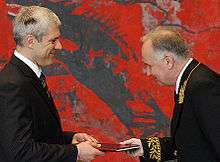
In 1834, the Russian Empire introduced diplomatic uniforms. As worn until 1917 these were of dark green (almost black) cloth with bicorn hats and braiding according to rank. Regulations introduced in 1904 specified six variations of the dark green uniform, depending on the nature of the occasion for which it was worn. These included plain uniforms without gold braid for office wear, plus white knee breeches and stocking for court functions when royalty were present. Peaked caps and epaulettes of military style were specified for street wear or informal occasions when the bicorn or braided tailcoat was considered unsuitable.
After the Russian revolution, a document entitled "Short Instruction on Adhering to the Accepted Bourgeois Society Etiquette Rules" by the People's Commissariat for Foreign Affairs (NKID) instructed the revolutionary diplomats to wear jackets on formal occasions. From 1923 to 1924, Moscow newspapers debated whether the wearing of civilian Western dress and thereby "bourgeois society symbols, which are totally alien to the spirit of the Workers' and Peasants' State" was appropriate, and there were calls for a Soviet diplomatic uniform to be introduced.[14]
But it was not until 1943 that a uniform was introduced for NKID staff, consisting of a three-piece uniform suit with gold-plated buttons and shoulder straps. The everyday uniform was grey and the dress uniform, which included a dagger, was black. Accoutrements included a coat, raincoat, hat and an ornate cap with the diplomatic insignia.[15] The black dress uniform was similar to the Nazi SS uniform; the Soviet diplomat Victor Israelyan recounted that during World War II he was once given the Hitler salute and a loud "Heil Hitler!" by a German prisoner of war who mistook him for an SS officer.[15]
The wearing of uniform by all Soviet diplomats on formal occasions was officially discontinued in 1954; thereafter only ambassadors continued to wear the dress uniform, without the dagger, on special occasions.[14][15] Senior officials of the Soviet Ministry of Foreign Affairs still wore a double-breasted black uniform (or white for the ones assigned in a country with a tropical climate) with gold braided cuffs and collar patches when attending credential presentations by foreign ambassadors, as late as the 1980s. Following the breakup of the Soviet Union these uniforms ceased to be worn in 1991, though they were not formally abolished. In 2001 a black diplomatic uniform was re-introduced resembling the former Soviet model except for new insignia and blue-green collar patches. Russia now maintains such uniforms for rare occasions.[16]
United Kingdom
Historic

British diplomats wore the official court uniform consisting of a dark blue button-down high-collar jacket with gold oak-leaf embroidery on the collar, chest, cuffs and long tails; white breeches were worn, or else dark blue trousers with gold stripes, and a cocked hat edged with white ostrich plumes. A white uniform, with similar but detachable panels of gold embroidery on the collar and cuffs, was worn in tropical postings.
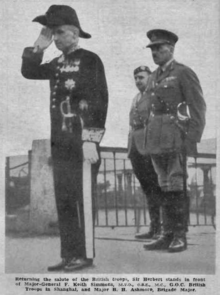
Ambassadors wore '1st Class' court uniform, with additional gold embroidery on the sleeve and back seams. More junior officers wore different classes of uniform with simplified braiding on cuffs and collars only, as specified for their rank or appointment, (the classes of uniform were differentiated by varying widths of gold embroidery). Members of the Consular Service wore court uniforms with silver braiding according to rank, in contrast to the gold of diplomatic officers. The King's or Queen's Foreign Service Messengers were entitled to '5th Class' court uniform, upgraded to '4th Class' in 1929.
Until about 1965 Foreign Office Regulations and Consular Instructions had required even junior foreign service officers to acquire this formal dress, following completion of their probation period. However, by the end of the 20th century the use of this uniform had greatly diminished.
Current
.jpg)
Today within Her Majesty's Diplomatic Service Heads of Mission (ambassadors, high commissioners, etc.) and their deputies retain a simplified Diplomatic Uniform for wear on formal occasions such as the presentation of credentials (and then only when accredited to certain countries). As worn by Deputy Heads of Mission, the uniform consists of a dark blue single-breasted tail coat, lined with black silk, with gilt buttons; the stand collar and gauntlet cuffs are faced with black velvet and edged with gilt braiding; this is worn with dark trousers or skirt, a bicorn hat, white gloves and a gold-mounted sword. Heads of Mission have, in addition, gold embroidery on the collar and cuffs, gold stripes on the trousers and a white ostrich-feather edging to the hat.[17] This form of uniform was introduced in the 1950s.
United States
.jpg)
American diplomats were first issued uniforms for the mission concluding the 1814 Treaty of Ghent; these consisted of a blue gold-embroidered coat, white breeches and stockings, a sword and a cocked hat with a black cockade. U.S. diplomats routinely designed and wore uniforms of their own choosing until 1817, when the State Department formally prescribed a uniform for ministers based on the one issued for the Ghent mission.[18] This uniform was recommended for use by all ministers abroad by Secretary of State John Quincy Adams in 1823.[19]
The Jackson administration simplified the uniform in 1829, which now consisted of a black coat with a gold star on each side of the collar, black or white breeches, a three-cornered chapeau de bras (i.e., a foldable tricorne hat), a black cockade and eagle, and a steel-mounted sword with white scabbard. This uniform was not mandatory, and some officials wore more brilliant uniforms according to their own taste.[19] In 1853, Secretary of State William L. Marcy issued a circular recommending that U.S. diplomats wear “the simple dress of an American citizen.”[18]
In response to what was perceived as the excessive ostentatiousness of some of these individualized uniforms, Congress banned diplomatic uniforms altogether in 1867, by passing a resolution forbidding diplomatic officials to wear "any uniform or official costume not previously authorized by Congress".[19] This caused some discomfort to American diplomats, who now had to appear "underdressed", in evening dress, to official functions. In 1910, Theodore Roosevelt attracted considerable attention when he was one of the few foreign representatives at the funeral of King Edward VII who was not in civil or military uniform.[1]
For a period of time, U.S. diplomats and consular officers wore modified U.S. Navy uniforms, much as the U.S. Public Health Service Commissioned Corps and U.S. National Oceanic and Atmospheric Administration Commissioned Corps continue to do so today. In 1937, President Franklin D. Roosevelt issued an executive order directing that no person in the diplomatic or consular service should wear a uniform or official costume not previously authorized by the United States Congress.[18]
While there has continued to be discussion on the idea of reintroducing uniforms for the U.S. Foreign Service, such as a modified U.S. Navy mess dress for formal occasions and presentation of credentials, such a change would require a law passed by Congress, since it is specified in the Foreign Service Act of 1946, section 1001, that "no officer or employee" of the Foreign Service was to "wear any uniform except such as may be authorized by law."[21]
References
- Hackspiel-Mikosch, Elisabeth (2005). "Uniforms, diplomatic". In Steele, Valerie (ed.). Encyclopedia of Clothing and Fashion. 3. Thomson Gale. pp. 362–364. ISBN 0-684-31394-4.
- Fred Gilbert Blakeslee, "Uniforms of the World", published by E.P. Dutten & Co. Ltd, 1929
- Fred Gilbert Blakeslee, page 311, "Uniforms of the World", published by E.P. Dutten & Co. Ltd, 1929
- Fred Gilbert Blakeslee, page 225, "Uniforms of the World", published by E.P. Dutten & Co. Ltd, 1929
- "The new Spanish ambassador in the Vatican presents his credentials to the Pope". Retrieved 3 June 2016.
- "New Danish Ambassador in Great Britain". Retrieved 3 June 2016.
- Dajō-kan Edict No. 339 of December 12, 1872. Taireifuku oyobi tsūjōreifuku wo sadame, ikan wo saifuku to nasu nado no ken (大礼服及通常礼服ヲ定メ衣冠ヲ祭服ト為ス等ノ件). View here.
- Dajō-kan Edict No. 373 of December 29, 1872. Taireifuku oyobi tsūjōreifuku chakuyoubi no ken (大礼服及通常礼服著用日ノ件). View here.
- Osakabe, Yoshinori (April 2010). 洋服・散髪・脱刀 : 服制の明治維新 [Western Clothes, Cut Hair, No Swords: The Meiji Restoration of Clothing] (in Japanese). Kodansha Ltd. ISBN 978-4-06-258464-7.
- JACAR (Japan Center for Asian Historical Records) Ref.A07090081700. 改定文官大礼服制表並図・勅奏任官 [Independent Documents: Tables and Illustrations on Revised Ceremonial Dress Code for Civil Officials: Officials under Imperial Appointment and Officials Appointed with the Emperor's Approval] (in Japanese).
- Kōki Hirota is seen in Japan News No. 111 and No. 166; Sawada Renzō in No. 24
- Imperial Household Ordinance No. 12 of May 2, 1947. Kōshitsurei oyobi fuzoku hourei haishi no ken (皇室令及附属法令廃止ノ件)
- Law No. 203 of July 1, 1954. Act on the Adjustment of Cabinet and Prime Ministerial Laws and Ordinances (内閣及び総理府関係法令の整理に関する法律, Naikaku oyobi sourifu kankei hourei no seiri ni kansuru houritsu)
- Lyadov, P.F. "Protocol and Etiquette". Russian Embassy in Chile (originally published in DIPLOMAT). Archived from the original on 3 October 2011. Retrieved 5 September 2010.
- Israėli︠a︡n, Viktor Levonovich (2003). On the battlefields of the cold war: a Soviet ambassador's confession. Penn State Press. pp. 20–21. ISBN 978-0-271-02297-0.
- "Sergey Lavrov, Igor Ivanov". Sulekha. Archived from the original on 24 October 2013. Retrieved 23 October 2013.
Russian Foreign Minister Sergey Lavrov, left, former Foreign Minister Igor Ivanov, center, both wearing official Russian diplomatic uniform, and Head of the Russian Chamber of Commerce and Industry Yevgeny Primakov, former Prime Minister, share a laugh after a meeting marking the professional holiday in Moscow, Wednesday, Feb. 10, 2010. (AP Photo)
- "Diplomatic Uniforms at the Holy See". Foreign & Commonwealth Office. Retrieved 2 June 2016.
- "Diplomatic and Consular Uniforms". Archived from the original on 15 April 2017. Retrieved 17 January 2011.
- Schuyler, Eugene (1886). American Diplomacy and the Furtherance of Commerce. Scribner's. pp. 62–63 (2009 reprint). ISBN 978-1-150-20435-7.
- Plischke, Elmer (1999). U.S. Department of State: A Reference History. Greenwood Press. pp. 148–150(1999 edition). ISBN 978-0-313-29126-5.
Further reading
- Davis, Robert Ralph (1968). "Diplomatic Plumage: American Court Dress in the Early National Period". American Quarterly. 20 (2): 164–179. ISSN 0003-0678. JSTOR 2711029.
- Buchner, Heide (2002). Nach Rang und Stand: Deutsche Ziviluniformen im 19. Jahrhundert (in German). Deutsches Textilmuseum. ISBN 978-3-00-009193-3.
External links
| Wikimedia Commons has media related to Diplomatic uniforms. |